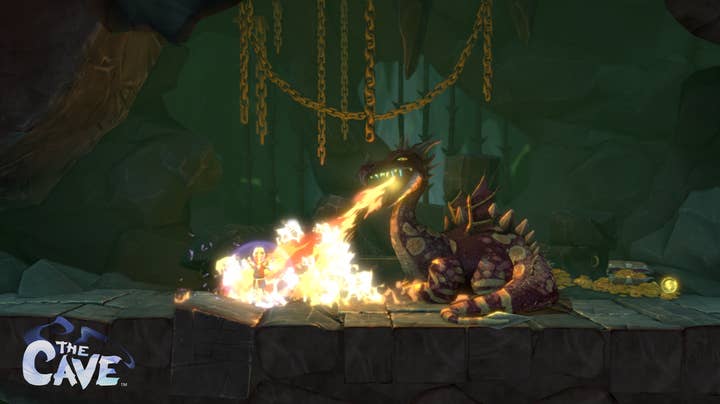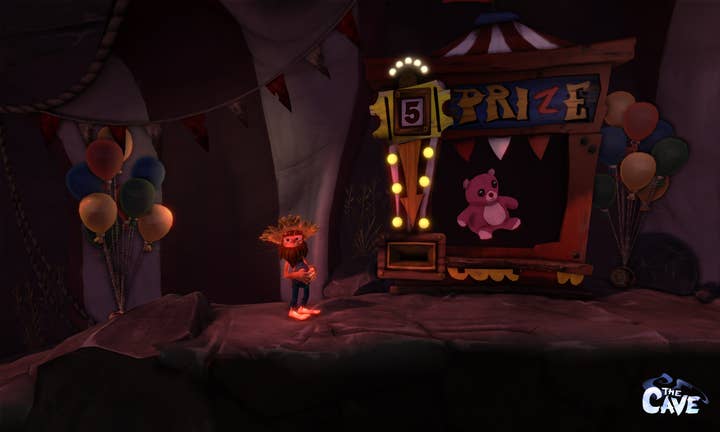Critical Consensus: The Cave
Ron Gilbert and Tim Schafer reunite for a new comic adventure. Rose-tinted spectacles at the ready.
Ninja Theory's reboot of Devil May Cry was greeted with harsh dismissal by the series' ardent fans, despite its developer's strong track record and a bare minimum of damning evidence. By contrast, Double Fine's latest release has been the focus of excitable anticipation from the moment it was announced: a new adventure game from Tim Schafer and Ron Gilbert, a reunion of the genre's brightest talents two decades after their golden years at LucasArts. If nostalgia is a double-sided sword, The Cave was fortunate enough to be struck by its dulled edge.
All of which goes to show that crowd-sourced wisdom should be taken well salted, because while DmC: Devil May Cry is now being praised as a brilliant new beginning for the franchise, The Cave has inspired no such rapture. Indeed, the bulk of the reviews published so far indicate that The Cave is merely good, and a number of revered outlets struggle to even go that far.
"This is a very funny game, with the cave itself narrating your actions in deadpan, lugubrious style"
Dan Whitehead, Eurogamer
For Eurogamer's Dan Whitehead, the most remarkable aspect of The Cave is how much Gilbert departs from the template of Maniac Mansion, Day of the Tentacle and Monkey Island. "Don't call it a comeback," he warns in his 7 out of 10 review, there may be item-led puzzles and droll, smutty humour, but The Cave isn't the return to past glories it was automatically assumed to be.
"Gilbert [has] taken the basics of the point-and-click genre and come up with a twist on the formula that makes it a better fit for today's gamer," he says. "Most noticeably, there's no pointing or clicking. This is as much co-operative platform game as single-player puzzler, and the structure and pace have been updated accordingly."
Any one playthrough of The Cave allows you to take three of the seven available characters into the recesses of a labyrinthine, self-aware cave system. A range of familiar archetypes are present and correct: a Knight, a Scientist, a Hillbilly, a Monk, and so on. Each has a unique ability that will be necessary to solve certain puzzles, and each has an area of the cave specifically designed to complement their backstory, personality and skills. According to Whitehead, The Cave handles its inventive premise "seamlessly", the cracks filled and smoothed by Gilbert's ear for a good gag.

"Gilbert's unmistakable sense of humour...remains as sharp as ever, some 20 years on from Guybrush Threepwood's seafaring yarns. This is a very funny game, with the cave itself narrating your actions in deadpan, lugubrious style. One puzzle involves honking the nose of a former cave explorer, a clown, long since turned to bones. Once you've honked it enough, he goes from 'Dead Clown' to 'Aroused Clown'."
On the subject of moment-to-moment jokes most critics seem to agree that The Cave is never less than mildly amusing, even if it rarely manages a legitimate belly-laugh. For those with the LucasArts-branded, rose-tinted glasses issued to so many gamers in the late-Eighties/early-Nineties, that will be more than enough to justify the £10/$15 Double Fine is charging. However, not all of The Cave's dark corners contain treasure - some of them contain almost nothing at all.
"The puzzle solutions are either immediately obvious, or simple enough that you're more likely to feel dumb for getting stuck than proud for solving it"
Edge magazine
For the hive-mind of Edge magazine, which deemed The Cave worthy of a 6 out of 10, the concept and wisecracks are undermined by its simplistic puzzles. There may not be any use-the-monkey-with-the-water-pump obscurantism found in Gilbert's earlier work, but there isn't much that will tax a reasonably competent player, either.
"The challenges expand to involve special abilities: the Hillbilly can hold his breath indefinitely, the Time Traveller can warp through walls, and the Scientist can hack computer terminals to unlock doors or control machinery. These powers are useful within each character's own area, but for around half the game's length you'll be making your way through parts of the Cave that all the characters encounter. This means the design of challenges can't rely on you having a particular power available, and so for stretches you'll find yourself forgetting that the abilities even exist.
"None of the puzzles offer the thrill of a eureka moment in the way that a good puzzle-platformer would. The solution is either immediately obvious, or simple enough that you're more likely to feel dumb for getting stuck than proud for solving it."

For Giant Bomb's Alex Navarro, an equally significant problem is the amount of backtracking across environments that's required to solve many of the puzzles. As a result, the game's few hard-earned Eureka moments are subdued by tedious journeys to put the plan into action - a situation only made worse when the solution is easy to discern.
"The disconnect in time between realising the solution and actually bringing the solution to fruition...frequently feels overlong," he says in his 3-star review. "In this regard, it can be difficult to really get into a rhythm with The Cave."
"The game's multiple-playthroughs-required design doesn't necessarily help this problem. While I did have fun going back and checking out the new levels I had access to on my second playthrough, I was less enamoured with having to play through the non-character-specific areas I'd already done. And I don't expect I'll be going back for a third go-around, either, due to the odd numbering of characters available. Having to replay two stories really doesn't sound appealing enough to warrant checking out that last one I haven't seen.
"There is most certainly fun to be had in The Cave. I just wish its promise of an eminently replayable adventure ultimately proved truer."

